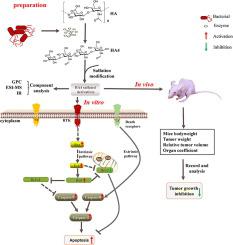Bioorganic & Medicinal Chemistry Letters ( IF 2.5 ) Pub Date : 2022-08-17 , DOI: 10.1016/j.bmcl.2022.128945 Xinyue He 1 , Sanying Wang 2 , Bing Liu 1 , Di Jiang 1 , Fen Chen 1 , Genxiang Mao 2 , Weihua Jin 1 , Hongying Pan 3 , Weihong Zhong 1

|
Hyaluronan (HA) is a glycosaminoglycan polymer involved in cell phenotype change, inflammation modulation, and tumor metastasis progression. HA oligosaccharides have a higher solubility and drug-forming ability than polysaccharides. HA tetrasaccharide was reported as the smallest fragment required for inhibiting triple-negative breast cancer, but the anti-tumor activity of HA tetrasaccharide (HA4) and its sulfated derivatives in lung cancer is still unknown. In this study, HA4 was prepared via HA degradation by chondroitinase ABC (CSABC), while its sulfated derivatives were prepared by sulfur pyridine trioxide complex in N, N-dimethylformamide (DMF). Then, the anti-tumor activity was detected via MTT assay and xenograft tumor experiments, while the expression level change of apoptosis genes was analyzed by qRT-PCR. Electrospray mass spectrometry (ESI-MS) analysis showed several HA4 sulfated derivatives, GlcA2GlcNAc2 (SO3H)n contains 0–6 sulfation groups, which mainly contain 3–6, 2–3, and 0–1 sulfation groups were classified as HA4S1, HA4S2, and HA4S3, respectively. After the addition of 1.82 mg/mL HA4, HA4S1, HA4S2, and HA4S3, the cell viability of A549 cells was reduced to 81.2 %, 62.1 %, 50.3 %, and 65.9 %, respectively. Thus, HA4S2 was chosen for further measurement, the qRT-PCR results showed it significantly up-regulated the expression of genes in the apoptosis pathway. Moreover, HA4S2 exhibited stronger antitumor activity than HA4 in vivo and the tumor inhibition rate reached 36.90 %. In summary, this study indicated that the CSABC enzyme could effectively degrade HA into oligosaccharides, and sulfation modification was an effective method to enhance the antitumor activity of HA tetrasaccharides.
中文翻译:

透明质酸四糖的硫酸化修饰增强了其在体外和体内对人肺腺癌细胞 A549 细胞的抗肿瘤活性
透明质酸 (HA) 是一种糖胺聚糖聚合物,参与细胞表型变化、炎症调节和肿瘤转移进展。HA寡糖比多糖具有更高的溶解度和成药能力。据报道,HA四糖是抑制三阴性乳腺癌所需的最小片段,但HA四糖(HA4)及其硫酸化衍生物在肺癌中的抗肿瘤活性仍不清楚。在本研究中,HA4 是通过软骨素酶 ABC (CSABC) 降解 HA 制备的,而其硫酸化衍生物是通过三氧化硫吡啶在N、N中的络合物制备的。-二甲基甲酰胺(DMF)。然后,通过MTT法和异种移植肿瘤实验检测抗肿瘤活性,同时通过qRT-PCR分析凋亡基因的表达水平变化。电喷雾质谱(ESI-MS)分析显示几种HA4硫酸化衍生物,GlcA2GlcNAc2(SO3H)n含有0-6个硫酸化基团,其中主要含有3-6、2-3、0-1个硫酸化基团,分为HA4S1、HA4S2 ,和HA4S3,分别。添加 1.82 mg/mL HA4、HA4S1、HA4S2 和 HA4S3 后,A549 细胞的细胞活力分别降低至 81.2%、62.1%、50.3% 和 65.9%。因此,选择HA4S2进行进一步测量,qRT-PCR结果显示它显着上调了细胞凋亡途径中基因的表达。此外,HA4S2 表现出比 HA4 更强的抗肿瘤活性在体内,抑瘤率达到36.90%。综上所述,本研究表明CSABC酶可以有效地将HA降解为寡糖,硫酸化修饰是增强HA四糖抗肿瘤活性的有效方法。











































 京公网安备 11010802027423号
京公网安备 11010802027423号